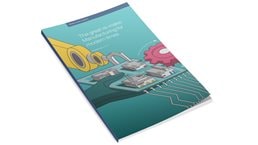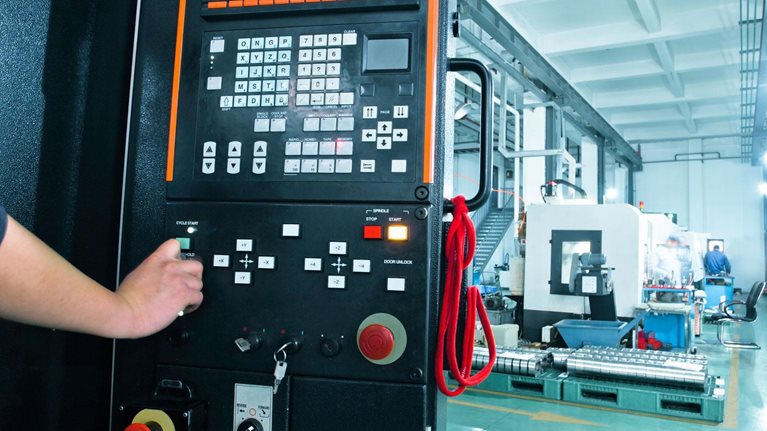In many ways, human progress has been defined by its use of increasingly sophisticated machines, from the simple lever to the steam engine and the electric motor to the most highly sophisticated robots. Today, most of us are surrounded by machines, and we rely on a complex web of them to provide the food, products, and utilities we use every day. By transforming and adding value to materials, energy, and information, machines drive around 85 percent of GDP in developed economies.
Stay current on your favorite topics
Machines aren’t just becoming more ubiquitous, however. They are also getting smarter, which is fundamentally reshaping how people use them. Traditionally—and to a great extent today—the performance of a machine depended on the performance of its human operators, relying on them to identify problems or opportunities for improvement and to make the necessary repairs and adjustments. Now machines are increasingly able to sense their own performance and health, to act on this information themselves, and to communicate it explicitly to operators and to other machines.
Together, these changes mean that getting machines right is becoming a key value driver in many organizations, by improving quality and flexibility, increasing yield, and reducing the consumption of energy and other inputs. We believe that the journey to optimal performance in the age of ubiquitous, intelligent machines will be driven by five fundamental principles (Exhibit 1).

Think lean
The lean approach has transformed the performance of human work in many settings. It is now time to apply the same focus to the machine. As with traditional lean, this method is based upon the identification and reduction of the primary sources of loss that erode operational performance and efficiency: inflexibility, variability, and waste.
The application of lean thinking to machines requires a change of perspective, however—one that considers the impact of losses on machine-specific attributes, such as energy consumption, yield, and reliability. If human operators are forced to wait for materials before conducting their work, for example, the losses each incurs will be very similar. Under the same circumstance, the losses incurred by machines may be very different. One machine may be able to shut down completely on demand, another may go on consuming energy and resources, and a third may generate large quantities of scrap as it brings its processes under control after the interruption.
Inflexibility
Human workers are inherently flexible. Flexibility has to be built, or programmed, explicitly into machines. Reducing the condenser pressure on a mechanical chiller in winter, for example, means it will consume less energy when the ambient temperature is lower. The efficiency of a gas boiler can be optimized by sensing the level of oxygen in the combustion chamber and adjusting it according to the required output. A fixed speed pump will consume excess energy any time its full output is not required; the addition of a variable speed drive on the pump’s motor can reduce those losses by allowing it to match its output, and energy consumption, precisely to changing demand. Designing equipment that can be easily adjusted to operate efficiently and reliably across various operating ranges or for various types of products allows cost-effective production in the short term, with the potential to defer or eliminate future capital expenditure.
Variability
Lean companies fight a relentless battle against the variability that affects product quality and production efficiency. They seek to minimize changes in raw material quality, for example, and eliminate inconsistent work processes. Optimal machine performance depends on tight control of variability as well. That involves designing machines and control systems that can deliver the desired output consistently over long periods, compensating for short-term changes in operating conditions, such as variations in temperature or humidity, and long-term ones, such as the effects of wear.
Would you like to learn more about our Operations Practice?
The traditional mechanisms used to control machine variability relied on rigorous processes to identify deviations in output, and the intervention of skilled operators to compensate for them. As machines become smarter and more adaptable, however, they can increasingly conduct this activity automatically, using closed-loop control systems to ensure consistency as internal and external conditions change. Even in very mature technologies, such as rolling mills, the latest smart control systems can increase machine performance over their counterparts by 2 or 3 percent, by identifying and predicting maintenance issues in advance and thereby allowing rapid repairs. This can translate into multimillion-dollar annual increases in output and a 30 to 50 percent decrease in associated costs.
Waste
The eight sources of waste1 identified in traditional lean thinking apply equally to machines. Overproduction, for example might include the choice of machines with significant excess capacity, or the application of multiple planned maintenance activities when one—or even none—would be more cost effective.
Optimizing planned preventive and predictive maintenance activities based on known or anticipated failures helps to insure that the correct maintenance activities are carried out if and only when required. Inventory waste attributable to poor machine reliability can include excessive stocks of tools and spare parts.
Other sources are more particular to the machine environment. These include the use of older equipment that consumes more energy or performs less reliably than its modern counterparts, or a failure to standardize equipment types, resulting in complex training and support requirements and large spare-parts inventories (Exhibit 2). Similarly, the desired performance and life-cycle characteristics of an asset need to be balanced with those of the wider production system. There is little point investing more capital for an asset that can run for ten years without a shutdown if the rest of a plant requires turnaround maintenance every three years.

Companies are increasingly making use of design-to-value techniques, including designing for reliability and for maintainability, to optimize the life-cycle costs of machines based on their required operating characteristics and maintenance requirements. For example, over its lifetime, the energy and maintenance costs of a simple pump can exceed the initial purchase cost by a factor of ten. Pumps that run more efficiently or that last longer between overhauls can recoup the higher purchase price many times over.
Think limits
When organizations think about machine performance today, they usually look at their current operations and search for ways they might be improved. That is an understandable impulse, but it represents only a partial solution. A more powerful approach is to begin by mapping out the theoretical limits of the machines—how they might operate in ideal conditions without losses from mechanical inefficiencies, nonstandard processes, flawed raw materials, or other sources. No machine can achieve the maximum theoretical performance in the real world, but by comparing the current performance with the theoretically ideal state, companies can identify the areas of their current production systems where the losses are greatest, and focus on improvement efforts there.
Losses identified by the theoretical-limit approach fall into two categories: design losses, which are determined by the physical characteristics of the machines involved, and operational losses, which are determined by how those machines are run and maintained (Exhibit 3). Since operational losses can often be addressed with little or no capital investment, they should be the initial focus of any improvement effort.

Think profit per hour
Will it be more effective to focus on increasing the availability of a critical machine or on improving its yield? When companies seek answers to questions like these in their quest to improve machine performance, they often find themselves comparing apples with oranges. Without a good way to balance the trade-offs inherent in the production systems, they risk investing in suboptimal efforts, or worse, making local changes that actually reduce overall equipment performance.
There is a single, robust metric that everyone inside and outside the manufacturing operation understands, however: profit. The challenge in applying this measure to details of production systems has traditionally been that monthly or quarterly profit reports are too coarse a measure. Today, however, thanks to the advent of rich, instantly available data, companies have access to a powerful new performance metric: profit per hour.
Every aspect of machine performance has an impact on profit per hour. Excess energy consumption adds cost, driving profit down. Yield improvements reduce input costs, driving it up. Reductions in downtime and unplanned stoppages mean more time spent producing with lower costs—and higher average profit per hour. Rolling all these diverse elements into a single metric automatically accounts for the trade-offs among different operating strategies.

The great re-make: Manufacturing for modern times
This 21-article compendium gives practical insights for manufacturing leaders looking to keep a step ahead of today’s disruptions.
Adopting the profit-per-hour methodology has allowed companies to find hidden improvement opportunities even in highly refined manufacturing operations (see “Extended lean toolkit for total productivity”). For some it is has been the key to dramatic overall performance improvements. One steelworks, for example, adopted the metric as the main performance indicator for its entire operation. Over a six-week period, the company introduced the metric to its full workforce, from production operators to the CEO. In the months that followed, profitability at the plant rose, and the impact was even more noteworthy, since it took place during a period when slumping global steel prices were forcing competitors to cut production and close entire plants.
Think holistically
Approaches such as the ones we’ve described so far are only part of the story. Creating an organization capable of getting the very best out of its machines will also require a comprehensive change-management effort. Companies will need to change people’s underlying mind-sets so that they think holistically about machine performance. Equally important, they will need to support those new mind-sets with revised metrics and more frequent performance dialogues as part of a new management infrastructure.
Machine performance will not just be the responsibility of the production, maintenance, or engineering functions. All functions within a manufacturing organization will play a key role, and all functions must be aligned to the performance expectations outlined.
One large factor in eliminating machine downtime and improving performance is the mind-set and behavior of machine operators. Employees who interact constantly with equipment are in the best position to monitor ongoing performance and equipment conditions. Operators can take on simple maintenance tasks, leaving maintenance technicians the time for more complex preventative and corrective work, for example.
The final—and increasingly critical—requirement for companies seeking to get the most out of their machines is analytical skill. As machines record and store more detailed data on their own performance, advanced-analytics techniques are set to play an increasingly important role in the optimization of performance. Taking advantage of this resource will require new infrastructure and new human capabilities, including the software and hardware and processes needed to store and manage the data, practitioners with the ability to generate useful insights from it, and the continuous-improvement functions that turn the insights into sustainable performance changes.
Think circular
Biological systems have evolved to make efficient use of scarce resources. Organisms repair themselves and adapt to changing requirements. The waste products they produce become valuable inputs into other processes. Circular thinking aims to use the same principles to dramatically improve the efficiency and productivity of the resources used in human-made systems. Its aim is to use fewer resources and eradicate waste, throughout the entire extended life cycle of a production system (Exhibit 4).

Companies can apply circular principles to machines in a number of ways. They can design machines that operate more efficiently and reliably to reduce their consumption of energy, water, or other inputs. They can focus on increasing yields to ensure more of the input material is converted into useful product. And they can explore the opportunity to use alternative inputs, too, allowing virgin raw materials to be replaced with recycled ones.
This approach also extends the useful life cycle of machines. By designing for reuse or renewal, the same basic platform can produce multiple generations of product, reduce capital costs, and improve an organization’s return on the machines it owns. A well-defined whole life-cycle approach means machines can keep delivering value longer. Sensors and control systems can be upgraded, for example, worn parts can be refurbished or remanufactured, and older machines can be reused in new applications and new locations—such as making simpler products for cost-sensitive emerging markets.
This article is adapted from Unlocking Industrial Resource Productivity: 5 core beliefs to increase profits through energy, material, and water efficiency, McKinsey Publishing, 2016.


